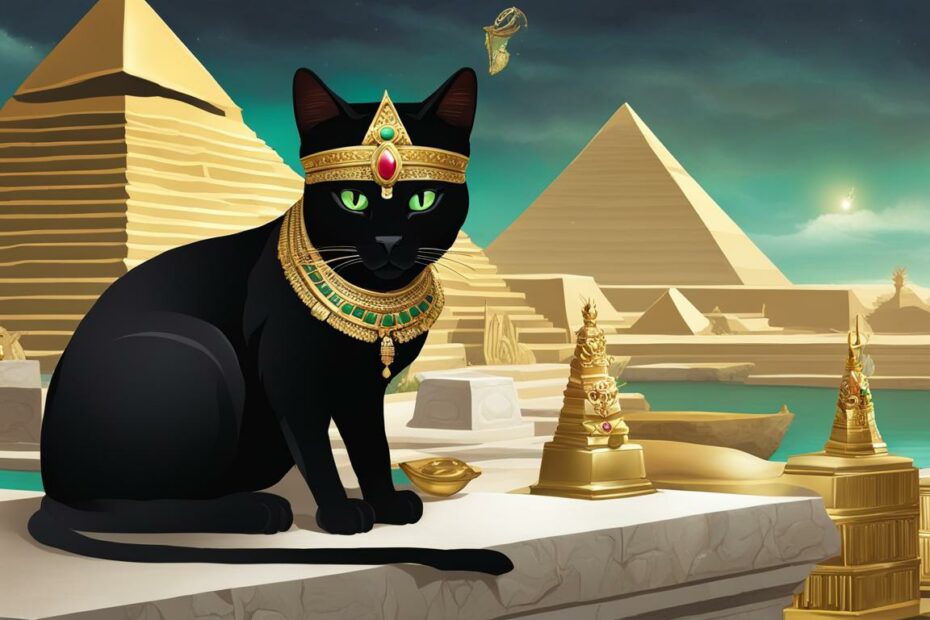Did you know that cats were revered as sacred creatures in ancient Egypt?
Explore the captivating world of ancient Egyptian cats and discover the extraordinary facts that shaped their role in Egyptian culture. From being worshipped for their perceived magical abilities to being mummified as a sign of deep reverence, cats held a special place in the hearts and minds of the ancient Egyptians.
Unravel the mysteries and delve into the cultural significance of these enchanting feline beings. Let us take you on a journey through history, art, and myth to understand the profound impact cats had on one of the greatest civilizations of all time.
Join us as we unveil the remarkable tales of ancient Egyptian cats, shedding light on their deification, symbolism, and enduring legacy. Get ready to embark on an adventure that will forever change the way you perceive these timeless creatures. Discover the true essence of ancient Egyptian cats and unravel the deeply-rooted bond between felines and the ancient civilization that worshipped them.
Ancient Egyptian Cat Worship
Cats held a special place in ancient Egyptian religion. Deities such as Bastet, the goddess who could transform into a cat, and Sekhmet, the lioness goddess of war, were represented with cat-like heads. The domestic cat became more popular in daily life, and cat-shaped decorations were used during the New Kingdom of Egypt.
Cats were depicted in association with the name of Bastet and were seen as symbols of fertility, protection, and divine aspects. They were often portrayed in art, both in two-dimensional paintings and three-dimensional sculptures. These depictions showcased the significance of cats in ancient Egyptian society and their close connection to Egyptian gods and goddesses.
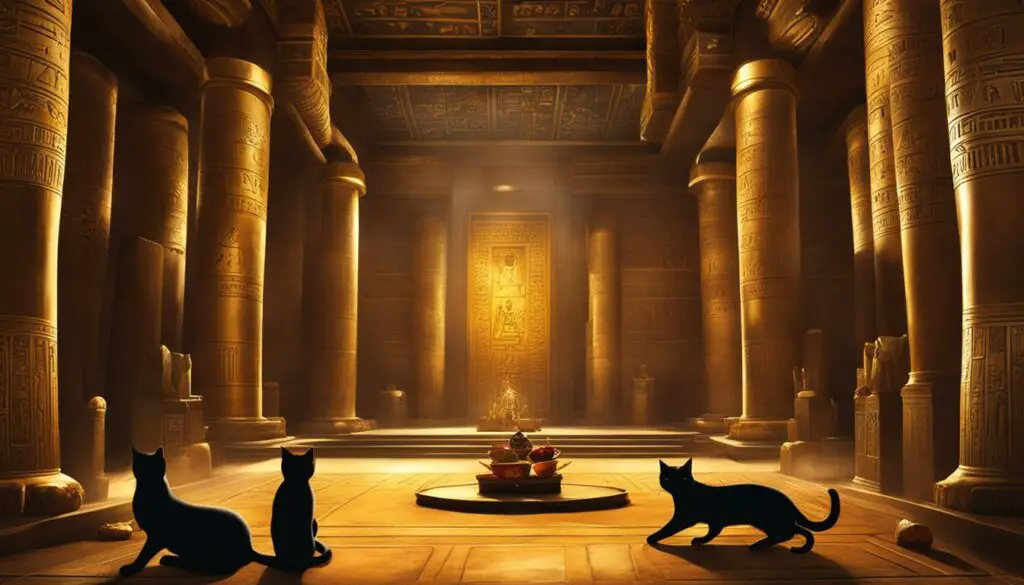
One notable example of the ancient Egyptian cat worship can be found in the cult of Bastet. Bastet was worshipped as a goddess of home, fertility, and childbirth. She was often depicted as a lioness or as a domestic cat. The association between cats and Bastet further solidified the reverence for these creatures in Egyptian culture.
Ancient Egyptian cat symbolism extended beyond religious beliefs. Cats were also believed to possess protective qualities, warding off evil spirits and bringing good fortune. This belief in their divine aspects contributed to their widespread popularity in ancient Egyptian society.
The influence of cats in ancient Egyptian religion and culture can still be felt today. The fascination with ancient Egypt cat worship has permeated modern culture, with cats being seen as mysterious, independent, and agile creatures. The legacy of cats in ancient Egypt serves as a testament to the enduring significance of these feline creatures.
Cats as Sacred Animals
Cats held a special place in ancient Egyptian culture and mythology, being revered as sacred animals and believed to possess divine qualities. They were considered vessels for Egyptian gods and were believed to be inhabited by divine aspects. Cats were even seen as messengers between humans and gods, facilitating communication and conveying important messages.
One prominent deity associated with cats was the goddess Bastet, who was often depicted as a domestic cat or as a lioness with the head of a lioness or a domestic cat. Bastet was revered as the protector of the home, fertility, and childbirth. She symbolized the nurturing and protective qualities often attributed to cats, making them highly valued in ancient Egyptian society.
A fascinating depiction of cats in Egyptian mythology can be found in some mortuary texts. In these texts, cats are shown with a dagger, representing their role in defending against threats. They are depicted cutting through the serpent deity Apopis, who was considered the enemy of the sun god Ra. This portrayal emphasizes the protective nature of cats and their association with safeguarding against evil forces.
The Goddess Bastet
One of the most notable representations of cats in Egyptian mythology is the goddess Bastet. She was often depicted as a lioness or a domestic cat and was associated with fertility, protection, and the household. Bastet was believed to bring good fortune and ward off evil spirits.
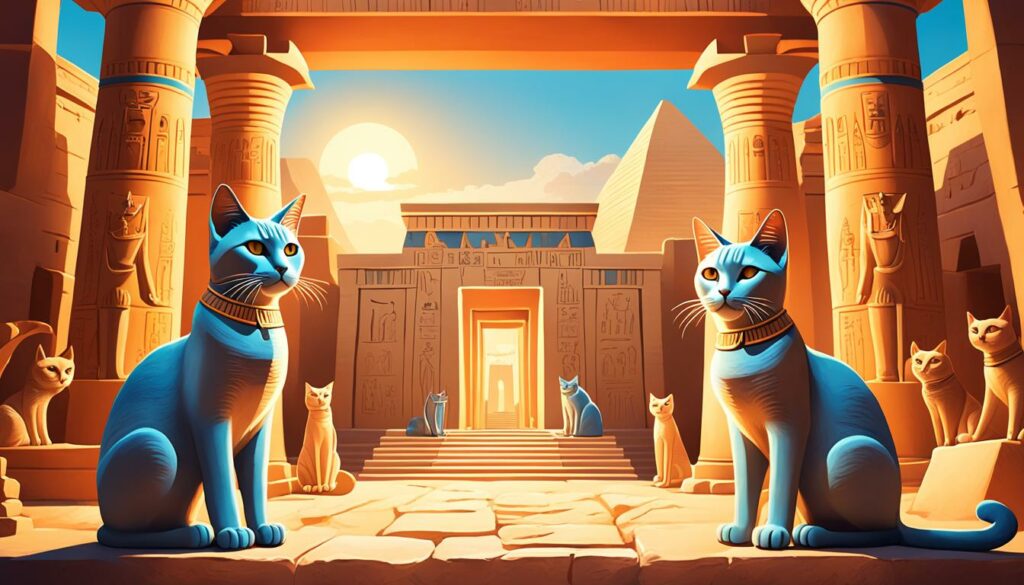
As the goddess of fertility, Bastet was worshipped to ensure the fertility of the land, livestock, and humans. She was closely linked to domestic cats, and her worshippers often had pet cats or statues of cats in their homes as representations of her divine presence.
Bastet’s association with protection extended to childbirth as well. Pregnant women would seek her blessings and the protection of their unborn children. It was believed that Bastet would ensure a safe and successful delivery.
The reverence for cats as sacred animals and their association with Egyptian gods is a testament to their importance in ancient Egyptian culture and mythology. The belief in their divine qualities and protective nature continues to captivate our imagination and reinforces the significant role cats played in history.
Cats in Ancient Egyptian Art and Culture
Cats played a prominent role in ancient Egyptian art and culture. They were not only valued for their perceived magical abilities and religious significance but also featured prominently in various artistic expressions of the time. Ancient Egyptians incorporated cats into their paintings, sculptures, and even tomb decorations, reflecting their deep appreciation for these feline creatures.
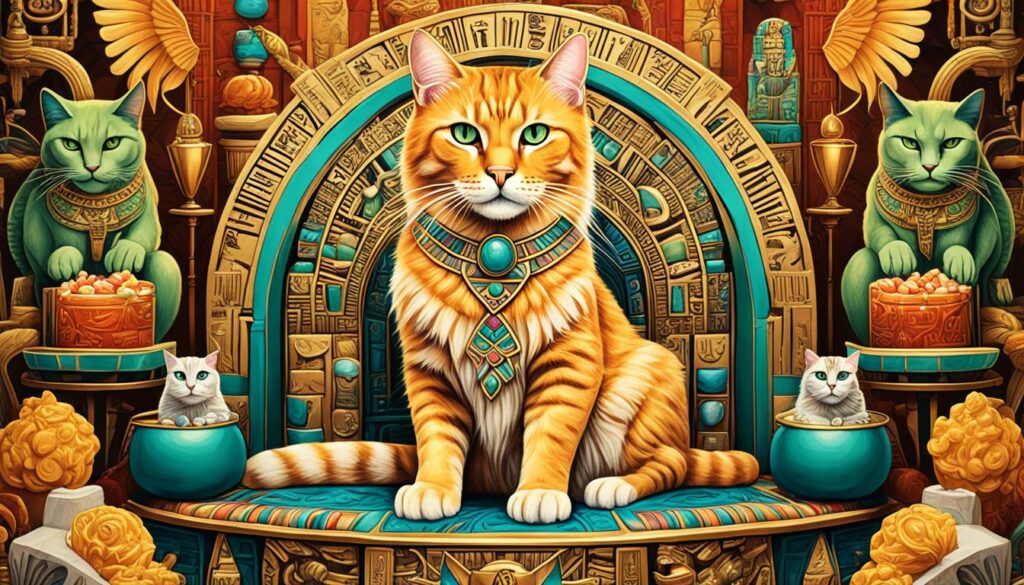
Cats in Art
In ancient Egyptian art, cats were often depicted in various activities. They were commonly shown sitting or lying below chairs, symbolizing their close association with domestic life. Cats chasing birds or hunting mice were also popular motifs in paintings and reliefs, representing their skilled hunting abilities and protective nature.
Cats in Tomb Decorations
A fascinating aspect of ancient Egyptian art is the representation of cats in tomb decorations. Paintings on tomb walls often depicted scenes of everyday life, where cats were shown as companions to their human owners. These illustrations emphasized the intimate relationship between humans and cats and signified their significance in the afterlife.
Discoveries of Pet Cemeteries
Recent archaeological discoveries have brought to light the existence of pet cemeteries in ancient Egypt, further highlighting the cultural importance of cats. These burial sites contained mummified cats, evidence of the high regard in which they were held. The presence of these pet cemeteries reveals that cats were beloved and respected animals, honored in death just as they were in life.
Cats in Egyptian Culture
Cats were not only appreciated for their companionship but were also revered for their protective qualities. Ancient Egyptians believed that cats had the ability to ward off evil spirits and bring good luck. They were considered sacred creatures and were closely associated with deities such as Bastet, the goddess of home, fertility, and childbirth.
| Role | Significance |
|---|---|
| Subject of Artistic Expression | Cats were featured in various forms of artwork, showcasing their importance in ancient Egyptian culture and society. |
| Symbol of Domestic Life | Depicted as sitting or lying below chairs, cats symbolized their close connection with human households. |
| Protective Figures | Ancient Egyptians believed that cats possessed protective qualities, guarding homes from malevolent forces. |
| Companions in the Afterlife | Tomb decorations revealed the inclusion of cats as beloved companions, ensuring their presence in the afterlife. |
| Sacred Connections | Cats were associated with deities such as Bastet, representing values like home, fertility, and protection. |
The depiction of cats in ancient Egyptian art and their inclusion in tomb decorations and pet cemeteries showcase the historical significance of these animals in Egyptian culture. Their representation as beloved companions and symbols of protection continues to captivate our imagination and serves as a testimony to the enduring legacy of cats in ancient Egypt.
The Mummification of Cats
In ancient Egypt, the mummification of cats played a significant role in their religious and cultural practices. Cats were mummified primarily as votive offerings for the gods associated with cats, such as Bastet, the goddess of home, fertility, and childbirth. The mummified cats were bought by temples and sold to pilgrims who would offer them to the gods as a gesture of devotion.
Entire industries were dedicated to breeding and mummifying cats, highlighting the importance of this practice in ancient Egyptian society. Cat cemeteries have been discovered at various archaeological sites, indicating the widespread mummification of these animals.
X-ray analysis of mummified cats has revealed a disturbing technique used in their preparation. The deliberate breaking of the cat’s neck was a common practice, suggesting that cats were purposefully bred for mummification. This gruesome process ensured that the cats’ bodies could be perfectly preserved, allowing them to accompany their owners into the afterlife.
To further explore the fascination with cat mummies in ancient Egypt and the cultural significance they held, refer to the table below:
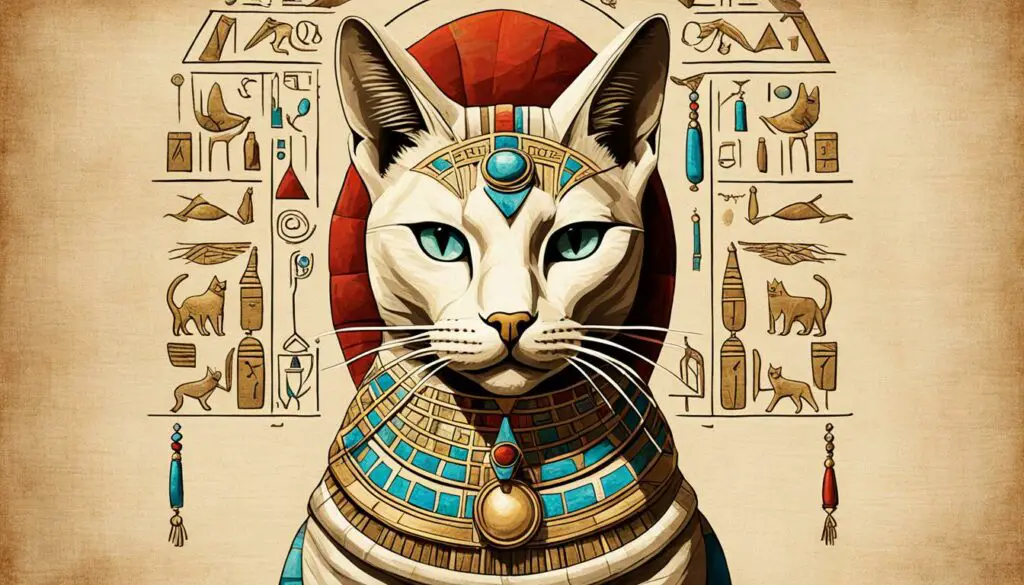
| Table: Importance of Cat Mummies in Ancient Egypt | |
|---|---|
| Cat Mummies were used as: | Evidence of piety and devotion to the gods |
| Pilgrim Offerings | Given as gifts to the temples |
| Symbol of Protection | Believed to ward off evil spirits and protect both the owner and the household |
| Religious Significance | Represented the owner’s religious beliefs and connected them with the divine |
Legacy of Cats in Ancient Egypt
The history of cats in ancient Egypt and their role in Egyptian mythology has left a profound impact on Western culture. Even today, cats are beloved pets and are often associated with qualities like independence, mystery, and agility.
Ancient Egyptian cat symbolism, with its depiction of cats in mythology and art, continues to captivate our imagination. The ancient Egyptians believed that cats possessed magical abilities and brought good luck. This belief, combined with the association of cats with deities like Bastet and Sekhmet, solidified their revered status in Egyptian society.
The legacy of cats in ancient Egypt serves as a testament to the enduring significance of these feline creatures. Their presence in Egyptian art, where they were depicted in paintings and sculptures, and their role in mythology as protectors of the home and symbols of fertility and childbirth, highlights their importance in ancient Egyptian culture.
The influence of ancient Egyptian cat symbolism can still be seen today, as cats continue to be adored and admired for their grace and allure. The history of cats in ancient Egypt resonates with cat lovers and enthusiasts, reminding us of the longstanding relationship between humans and these fascinating creatures.
FAQ
Q: Did ancient Egyptians worship cats?
A: Yes, ancient Egyptians worshipped cats for their perceived magical abilities and considered them to bring good luck. They even adorned their cats with jewels and treated them like royalty.
Q: Were there any deities associated with cats in ancient Egypt?
A: Yes, deities such as Bastet, the goddess who could transform into a cat, and Sekhmet, the lioness goddess of war, were represented with cat-like heads. Cats were considered sacred vessels for Egyptian gods and were believed to be inhabited by divine aspects.
Q: What role did cats play in ancient Egyptian art and culture?
A: Cats played a prominent role in ancient Egyptian art and culture. They were often depicted in paintings and sculptures, hunting, chasing birds, or sitting below chairs. Cats were also buried alongside people, emphasizing their importance in society.
Q: How were cats mummified in ancient Egypt?
A: Cats were mummified in ancient Egypt primarily as votive offerings for the gods with cat associations, such as Bastet. Cat mummies were bought by temples to sell to pilgrims who offered them to the gods. Entire industries were dedicated to breeding and mummifying cats, and cat cemeteries were found at various archaeological sites.
Q: What is the legacy of cats in ancient Egypt?
A: The reverence for cats in ancient Egypt has had a lasting impact on Western culture. Cats continue to be popular pets today and are often associated with independence, mystery, and agility. Ancient Egyptian cat symbolism has influenced how cats are perceived, and their presence in mythology and art still captivates our imagination.
